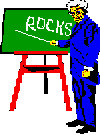Good Practices - Departments
Good Practices

Departmental Commitment
Few departments have made a commitment to distributing learning materials on the Internet. Most of what you see is the result of the initiative of one or a few faculty members. However, there are several notable exceptions. If you and your colleagues are talking about whether a department initiative to produce Internet-based course resources is a worthwhile goal, look through the offerings of the departments listed below.
- Faculty in the Department of Earth and Environmental Sciences at Columbia University and some of their colleagues at Barnard College have redesigned the introductory course sequence for their Environmental Sciences major. The Site Map provides an outline view for the Climate, Solid Earth System and the Life System - the three semester introductory sequence. The heart of the sequence is their New Data Viewer which is used in some of the laboratories as well as in the lecture portion of the course.
- The Department of Geological Sciences faculty at Cornell University seem to have made a similar commitment. You will find resources ranging from little more than an Internet-based syllabus to complete texts delivered in pdf format. You can track the development of their resources back to the spring semester of 1997.
- The Department of Geosciences at the University of Arizona has been experimenting with design for several years and have recently abandoned the course-from-a-box, all look-alike approach to productions that look different and probably reflect the personalities of its faculty.
- The College of Earth and Ocean Sciences- EOS, Faculty of Science - at the University of British Columbia has been experimenting with delivering course resources on the Internet since about 1994 and more than 40 links to more than 40 courses with Internet-based resources are given on their pages. If you browse through their materials you will find that each course "looks" different yet there are common resources which the courses share. Take a look at WWW EOS Educational Resources. If you want to get an idea as to where your individual and collective efforts could lead, these EOS sites are perhaps your best starting point.
- The Department of Geology at the University of Michigan has created a range of Internet-based course resources which must reflect the diverse interests of the faculty.
- The Department of Geology at the University of Florida offers a number of Internet-based course resources with a rather different look and feel which must reflect the influence of the faculty who are developing the pages. In addition, there are a number of Earth System Science resources that should be of interest to faculty who are preparing resources for freshman-level courses.
- The Department of Geological Sciences at the University of Texas at Austin, have endorsed using the Internet to distribute course resources. The look and feel ranges from a "standardized format" to the work of individuals. This is another site worth exploring to get an idea as to the variety of materials that can be distributed.
- The Department of Geology and Geophysics at the University of Utah have expressed a committment to producing Internet-based resources for many of their courses. These are not "courses-in-a-box" and seem to reflect the different personalities on the faculty who are developing (or at least helping to develop) these resources. They offer a collection of Exploring the Earth Applets that may be of particular importance to faculty looking for good Internet-based demonstrations.
There are nearly 220 departments producing Internet-based course resources and you can explore these resources in the FileMaker Pro Database
January 15, 2001
Return to the Virtual Geosciences Professor's Good Practices Home Page
